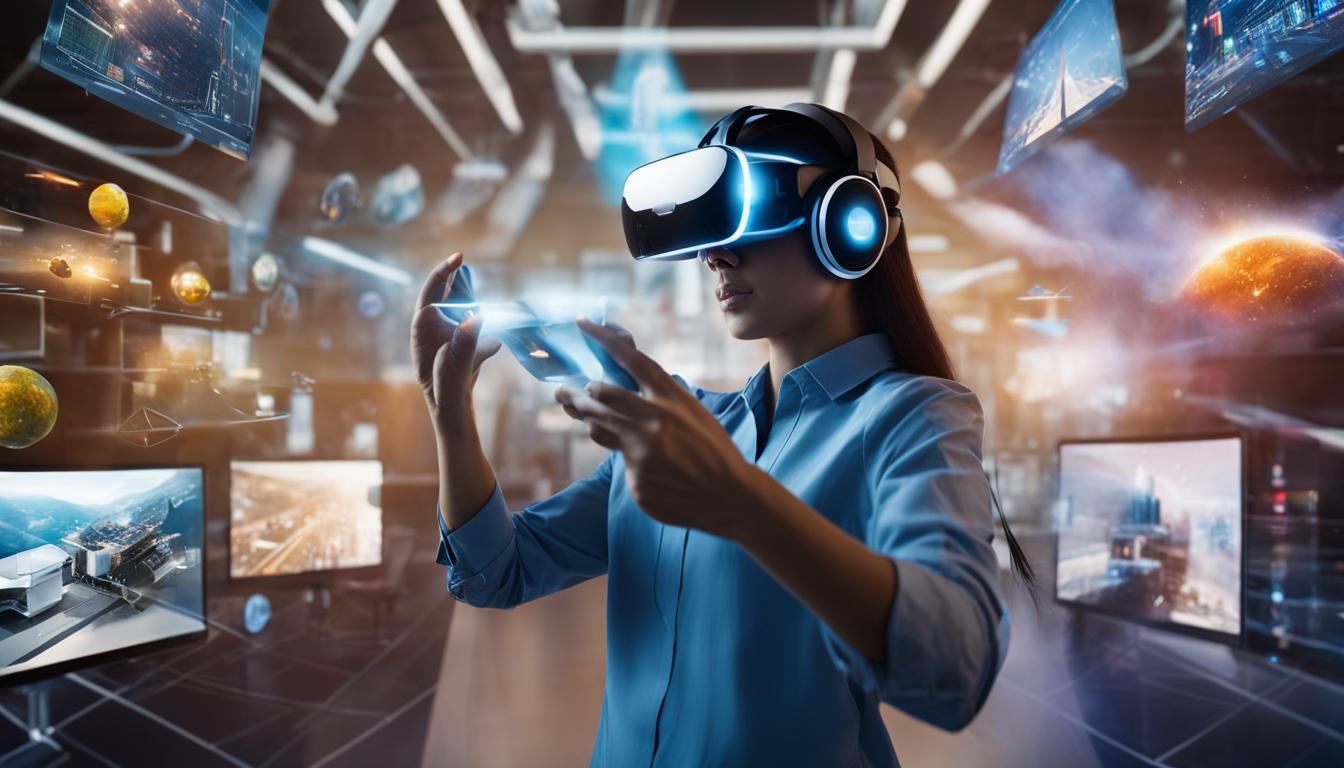Augmented reality (AR) is not just a futuristic concept anymore. It has emerged as a game-changer across industries, offering exciting business opportunities for startups and entrepreneurs. By blending virtual elements with the real world, AR technology has the potential to transform customer experiences, education and training, retail, architecture, advertising, and more.
In this article, we will delve into the current augmented reality business opportunities and explore the potential ideas that can fuel innovation and growth in this dynamic field. Whether you are a seasoned entrepreneur or someone looking to venture into the AR market, this piece will provide valuable insights to help you make informed decisions and unlock the full potential of augmented reality for your business.
Contents
- 1 AR in Shopping: Transforming the Retail Industry
- 2 AR in Education: Transforming Learning Experiences
- 3 AR in Architecture and Design: Enhancing Visualization and Collaboration
- 4 AR in Advertising and Marketing: Engaging Customers in Unique Ways
- 5 Conclusion
- 6 FAQ
- 6.1 What are some business opportunities in augmented reality?
- 6.2 How is augmented reality transforming the retail industry?
- 6.3 How is augmented reality being used in education?
- 6.4 How does augmented reality enhance visualization and collaboration in architecture and design?
- 6.5 How can businesses engage customers through augmented reality in advertising and marketing?
- 7 Source Links
Key Takeaways:
- Augmented reality offers exciting business opportunities across various industries.
- AR can enhance customer experiences, education, retail, architecture, and advertising.
- Startups and entrepreneurs can capitalize on the potential of AR technology.
- Developing AR apps and platforms tailored to specific industries can drive innovation.
- The growing adoption of AR technology indicates a promising future for businesses in this market.
AR in Shopping: Transforming the Retail Industry
Augmented reality (AR) is revolutionizing the retail industry, offering shoppers unique and immersive experiences that enhance engagement and drive sales. According to a recent survey, a staggering 61% of consumers prefer shopping at stores that provide AR experiences, highlighting the growing demand for this transformative technology.
AR provides customers with the ability to visualize products in their real-world environment, making it easier to make informed purchasing decisions. This not only reduces the likelihood of returns but also increases customer satisfaction and builds brand loyalty. With AR, shoppers can virtually try on clothing, experiment with different home decor options, and even preview how furniture would look in their living space.
Successful Examples
Many retail giants have already embraced AR technology and reaped its rewards. For instance, IKEA’s “IKEA Place” AR app allows users to virtually place furniture items in their homes to determine if they fit the aesthetics and dimensions of their space. This hands-on experience eliminates guesswork and enhances the shopping experience.
“AR enhances customer engagement by allowing them to visualize products in their real-world environment, reducing the likelihood of returns.”
Another successful example is Sephora’s “Virtual Artist” AR app, which enables customers to virtually try on makeup products and experiment with different looks. This interactive experience empowers shoppers to make confident beauty purchases without stepping foot in a physical store.
Opportunities for Startups
Startups in the retail industry can capitalize on the growing trend of AR in shopping by developing innovative AR apps. For example, an AR app that suggests clothing based on user preferences and provides personalized shopping experiences can revolutionize the way customers discover new fashion trends. By leveraging AR’s capabilities, startups can stand out in a crowded market and attract tech-savvy consumers seeking unique shopping experiences.
Moreover, AR can also have a significant impact on online shopping. By integrating AR technology into e-commerce platforms, customers can virtually try on products before making a purchase, reducing the barrier of uncertainty and enhancing customer trust. This immersive shopping experience can lead to higher conversion rates and increased customer satisfaction.
To summarize, AR in shopping is transforming the retail industry, providing customers with immersive experiences that enhance engagement and improve decision-making. Startups have an opportunity to tap into this growing trend by developing AR apps that offer personalized shopping experiences, virtual try-ons, and innovative features that cater to the evolving needs of tech-savvy consumers.
| Benefits of AR in Shopping | Examples |
|---|---|
| Enhanced customer engagement | IKEA Place |
| Reduced likelihood of returns | Sephora Virtual Artist |
| Improved decision-making | |
| Personalized shopping experiences | |
| Increased customer satisfaction |
AR in Education: Transforming Learning Experiences
Augmented reality (AR) has emerged as a powerful tool in revolutionizing the field of education. By integrating virtual elements into the real world, AR creates immersive and interactive learning experiences that captivate students’ attention and enhance knowledge retention.
One of the key advantages of AR in education is its ability to bridge accessibility gaps and reach students in remote or underserved areas. With AR, educational content can be accessed anytime and anywhere, enabling students to engage with learning materials beyond the confines of traditional classrooms.
“AR has the potential to completely transform education by making it more interactive, engaging, and accessible for all students.”
Two notable examples of AR projects in the educational niche are Merge EDU and SketchAR.
Merge EDU
Merge EDU is an innovative platform that utilizes AR to bring learning to life. Through the Merge Cube, a physical object that interacts with virtual content, students can explore subjects like anatomy, astronomy, and chemistry in a hands-on and immersive manner.
The Merge EDU platform also provides teachers with a library of AR lessons and activities that align with curriculum standards, enabling them to integrate AR seamlessly into their teaching practices.
SketchAR
SketchAR leverages AR technology to enhance art education. With the SketchAR app, aspiring artists can trace outlines of famous artworks or create their own original pieces by overlaying virtual sketches onto real-world surfaces.
SketchAR promotes creativity and improves artistic skills by providing step-by-step guidance and real-time feedback, making art education more accessible and enjoyable for individuals of all ages and skill levels.
Another exciting application of AR in education is the creation of virtual science labs. These labs offer students the opportunity to conduct experiments in a safe and interactive virtual environment, eliminating the need for expensive lab equipment and minimizing risks associated with traditional labs.
Imagine a virtual chemistry lab where students can mix chemicals, observe reactions, and analyze results in real-time. This immersive experience allows students to develop a deeper understanding of scientific concepts through hands-on experimentation.
To illustrate the transformative power of AR in education, let’s take a look at a table showcasing the benefits of AR in schools:
| Benefits of AR in Education | Examples |
|---|---|
| Enhanced engagement and interactivity | Merge EDU, SketchAR |
| Bridge accessibility gaps | Merge EDU, virtual science labs |
| Improved knowledge retention | SketchAR, virtual science labs |
As AR technology continues to advance, the potential for transforming learning experiences in schools is boundless. From interactive lessons to virtual labs, AR opens up a whole new world of educational possibilities for students and educators alike.
Next, we will explore another exciting application of AR in the field of architecture and design.
AR in Architecture and Design: Enhancing Visualization and Collaboration
Augmented reality (AR) technology is reshaping the architecture and design sectors, providing exciting opportunities for innovation. With AR visualization, designers can now showcase their projects in a real-world context, revolutionizing the way they collaborate with clients. By visualizing designs in AR, architects and interior designers can present their ideas in a more immersive and interactive manner, allowing clients to experience the space before it’s built.
One of the key benefits of AR in architecture is the ability to identify design flaws early in the process. By visualizing the design in AR, designers can detect any potential issues, such as poor spatial planning or aesthetic inconsistencies. This enables them to make necessary adjustments before construction begins, resulting in significant cost savings and ensuring a more efficient project timeline. AR has the potential to revolutionize architectural design trends by combining it with technologies such as artificial intelligence (AI) and 3D printing.
“AR offers an exciting new way to present designs to clients in a more interactive and visually compelling manner.”
– John Adams, Senior Architect at XYZ Architects
Startups in the architecture and design industry can leverage AR technology to develop innovative applications that enhance interior design visualization. These apps can allow users to experiment with different layouts, colors, and furniture arrangements, providing a realistic preview of their vision for a space. By enabling users to virtually change and visualize their home interiors, these apps empower them to make confident design decisions.
Here’s an example of how an AR interior design app can revolutionize the industry:
| Traditional Interior Design Process | AR-enabled Interior Design Process |
|---|---|
|
|
With AR, clients can now bypass the traditional interior design process, saving time and money. They can browse through a virtual catalog of furniture, finishes, and decor, visualizing them in their own space. This not only streamlines the design process but also ensures that clients are satisfied with the final result.
By embracing AR technology, the architecture and design industries are unlocking new possibilities for creativity, collaboration, and client satisfaction. With the continued advancement of AR, we can expect to see more sophisticated tools and applications that further enhance the visualization and design process.

AR in Advertising and Marketing: Engaging Customers in Unique Ways
In today’s competitive marketplace, businesses are constantly searching for innovative ways to capture the attention of their target audience. Augmented reality (AR) provides a unique and interactive experience that can revolutionize advertising and marketing campaigns. By incorporating AR technology, businesses can engage customers in ways that traditional advertising methods simply can’t match.
Creating Interactive Experiences
AR allows businesses to create engaging experiences that captivate customers and make a lasting impression. Imagine a customer attending a business conference or trade show and receiving a business card with AR elements. With a simple scan of the card using their smartphone, they are transported into an interactive world that showcases the company’s products or services. This not only grabs their attention but also leaves a memorable brand experience.
Furthermore, businesses can use AR to take customers on virtual adventures. By creating immersive storytelling experiences or gamified campaigns, brands can generate excitement and build a deeper connection with their audience. Augmented reality marketing campaigns have the ability to capture the imagination and create buzz around a brand or product.
Real-World Examples
“AR represents a significant leap forward in advertising and marketing. It allows us to engage customers in unique and memorable ways, creating a lasting impact on their perception of our brand.” – Marketing Director, XYZ Corporation
Leading brands have already embraced AR in their advertising and marketing strategies, showcasing its effectiveness. For instance, Uber ran an AR campaign that allowed users to hail virtual cars, creating a playful and interactive experience. Apple utilized AR to provide customers with a lifelike visualization of their products, allowing them to see how Apple devices would fit into their daily lives. These examples are a testament to the power of AR in captivating customers and differentiating brands from their competitors.
Strengthening Customer Loyalty
AR not only captivates customers but also strengthens their loyalty to a brand. By providing interactive and immersive experiences, businesses create a deeper emotional connection with their audience. This emotional connection can be a driving force behind customers choosing one brand over another.
| Benefits of AR in Advertising and Marketing |
|---|
| Enhances customer engagement and interaction |
| Creates memorable brand experiences |
| Generates excitement and buzz around a brand |
| Strengthens customer loyalty |
Building customer loyalty is crucial for businesses today, as it leads to repeat purchases, positive recommendations, and long-term relationships. AR in advertising and marketing enables brands to forge these strong connections with their customers, resulting in increased customer satisfaction and loyalty.

AR in advertising and marketing presents endless possibilities for businesses seeking to engage customers in unique and memorable ways. By capitalizing on this technology, businesses can differentiate themselves from competitors and create lasting impressions on their target audience. Are you ready to harness the power of augmented reality in your advertising and marketing campaigns?
Conclusion
Augmented reality (AR) presents numerous business opportunities across industries such as retail, education, architecture, and advertising. By harnessing the power of AR, businesses can enhance customer experiences, improve education and training, transform the retail sector, and create innovative marketing campaigns.
Startups and entrepreneurs can capitalize on these opportunities by developing AR apps and platforms that meet the specific needs of each industry. For retail, AR apps can provide virtual try-ons, personalized shopping experiences, and suggest products based on user preferences. In education, AR can revolutionize learning by offering virtual science labs and interactive educational content accessible to remote areas. Architects and designers can leverage AR to visualize projects in the real world, collaborate with clients, and identify design flaws early on.
Furthermore, AR in advertising and marketing allows businesses to engage customers in unique ways. By incorporating AR elements into campaigns, such as creating virtual adventures or using AR on business cards, businesses can differentiate themselves and provide a memorable brand experience. The growing adoption of AR technology indicates a promising future for businesses in the augmented reality market.
In conclusion, augmented reality opens up exciting possibilities for businesses across various industries. By embracing AR, businesses can stay ahead of the curve, enhance their offerings, and create immersive experiences that captivate customers. With the right AR apps and platforms, startups and entrepreneurs can tap into this thriving market and pave the way for a successful future.
FAQ
What are some business opportunities in augmented reality?
Augmented reality presents opportunities across various industries, including retail, education, architecture, and advertising. Businesses can leverage AR technology to enhance customer experiences, improve education and training, revolutionize the retail sector, and create immersive marketing campaigns.
How is augmented reality transforming the retail industry?
Augmented reality is reshaping the retail industry by offering unique and immersive shopping experiences. By leveraging AR, businesses can allow customers to visualize products in their real-world environment, reducing the likelihood of returns. AR apps can suggest clothing based on user preferences, provide virtual try-ons, and offer personalized shopping experiences.
How is augmented reality being used in education?
Augmented reality has immense potential in education as it can make learning more engaging and interactive. AR technology improves knowledge retention and bridges accessibility gaps by bringing educational content to remote or underserved areas. Platforms offering virtual science and chemistry labs allow students to conduct experiments in a safe and interactive virtual environment.
How does augmented reality enhance visualization and collaboration in architecture and design?
Augmented reality visualization technology allows designers to display their architectural projects in a real-world context, making collaboration with clients easier. AR can also identify design flaws early in the process, resulting in cost savings. Startups can develop apps that allow users to plan and visualize interior design changes, experimenting with different layouts, colors, and furniture arrangements.
How can businesses engage customers through augmented reality in advertising and marketing?
Augmented reality offers a unique and interactive experience in advertising and marketing. Businesses can create engaging AR experiences that differentiate them from competitors, such as using AR elements on business cards or creating virtual adventures for customers. By leveraging AR technology, businesses can strengthen customer loyalty and provide a memorable brand experience.




